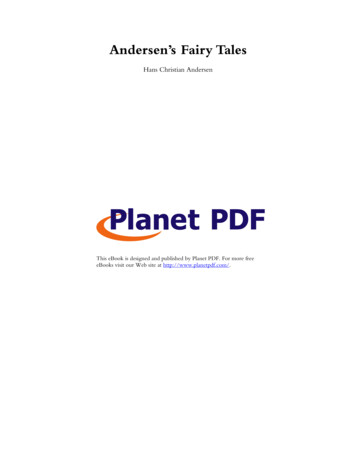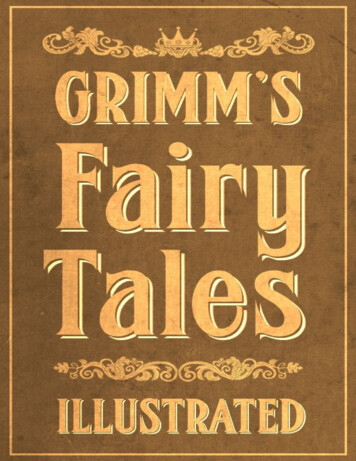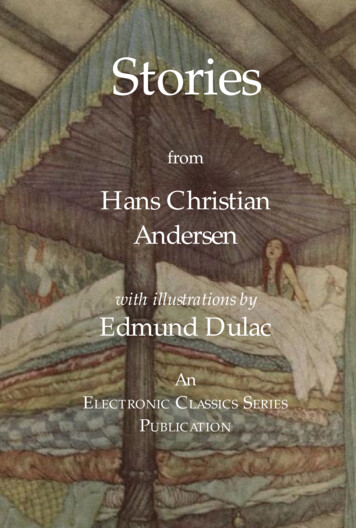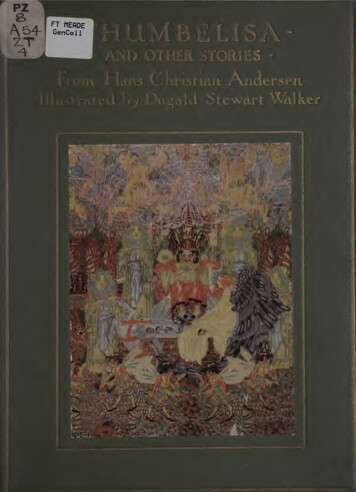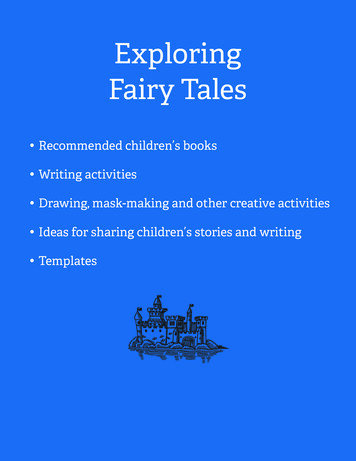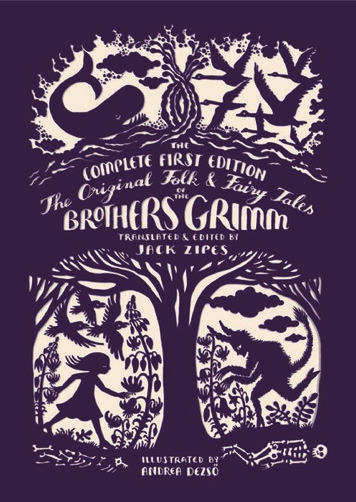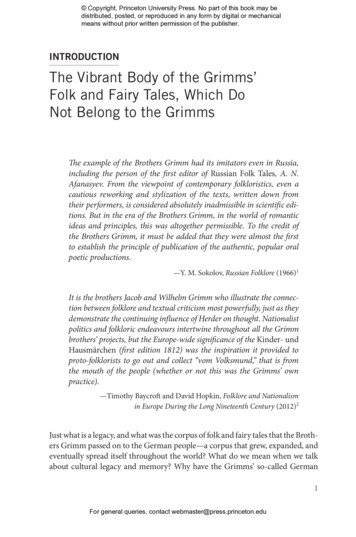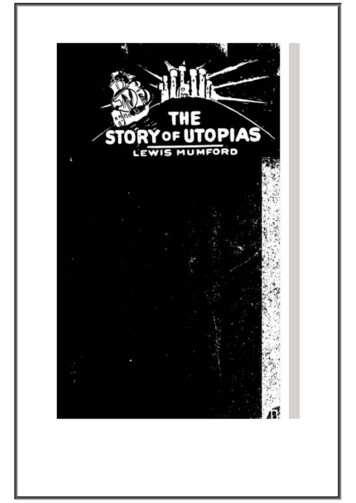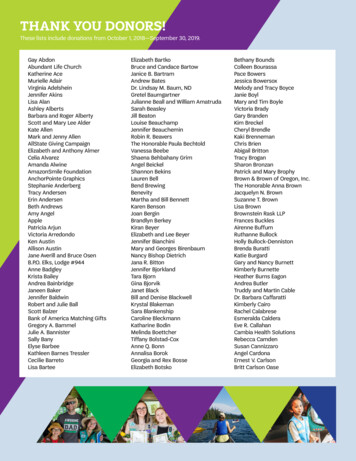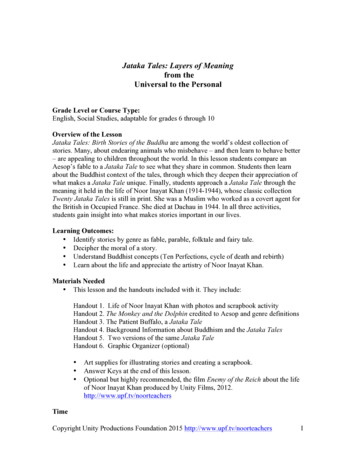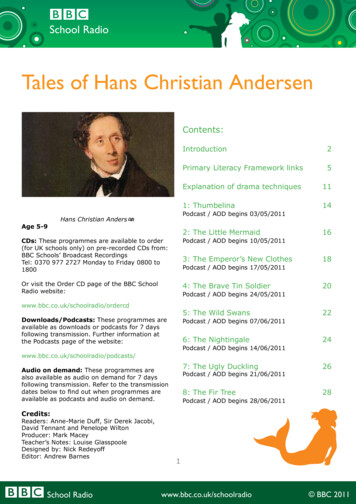
Transcription
School RadioTales of Hans Christian AndersenContents:Age 5-9Introduction2Primary Literacy Framework links5Explanation of drama techniques111: Thumbelina142: The Little Mermaid163: The Emperor’s New Clothes184: The Brave Tin Soldier205: The Wild Swans226: The Nightingale247: The Ugly Duckling268: The Fir Tree28Podcast / AOD begins 03/05/2011Hans Christian AndersHnPodcast / AOD begins 10/05/2011CDs: These programmes are available to order(for UK schools only) on pre-recorded CDs from:BBC Schools’ Broadcast RecordingsTel: 0370 977 2727 Monday to Friday 0800 to1800Podcast / AOD begins 17/05/2011Or visit the Order CD page of the BBC SchoolRadio website:Podcast / AOD begins ds/Podcasts: These programmes areavailable as downloads or podcasts for 7 daysfollowing transmission. Further information atthe Podcasts page of the website:Podcast / AOD begins 07/06/2011Podcast / AOD begins 14/06/2011www.bbc.co.uk/schoolradio/podcasts/Audio on demand: These programmes arealso available as audio on demand for 7 daysfollowing transmission. Refer to the transmissiondates below to find out when programmes areavailable as podcasts and audio on demand.Podcast / AOD begins 21/06/2011Podcast / AOD begins 28/06/2011Credits:Readers: Anne-Marie Duff, Sir Derek Jacobi,David Tennant and Penelope WiltonProducer: Mark MaceyTeacher’s Notes: Louise GlasspooleDesigned by: Nick RedeyoffEditor: Andrew BarnesSchool Radio1www.bbc.co.uk/schoolradio BBC 2011
SchoolRadioSchool RadioIntroductionTales of Hans Christian AndersenHans Christian Andersen, 1805-1875A common theme of Andersen’s work is theunfortunate or the outcast. This is likely tohave arisen from the experiences of his ownlife – the teasing he suffered as a child and therejection he suffered in his personal life as anadult. Despite proposals made to several women,Andersen never married. He died of canceron 4th August 1875, and was subsequentlycommemorated in his home city of Copenhagenthrough the statue of his character the LittleMermaid, which can be found by the harbourthere.Hans Christian Andersen was born in humblesurroundings in Odense, Denmark, on 2April, 1805, the son of a shoemaker and awasherwoman. His father loved literature andencouraged young Hans to write tales and put onpuppet shows. However, he died when Hans wasjust 11, which meant that the boy was sent outto work in order to support the family. He workedin a tailor’s shop and tobacco factory, but wasdeeply unhappy, often being teased about hisappearance (tall and thin with a long nose andclose-set eyes) and his effeminacy.At age 14 Hans moved to the capital cityCopenhagen in an attempt to pursue a careerin the theatre. Initial success as a singer cameto a halt when his voice broke, but associatescomplemented him on his poetry and he alsobegan to write plays.One of the theatre directors arranged for someformal education to be paid for and Hansattended Copenhagen University. Hans was alsoable to travel widely around Europe, meetingvarious famous writers including Victor Hugo,Alexandre Dumas and Charles Dickens. Andersencontinued to travel extensively throughout hisadult life and often drew inspiration from histravels to aid his writing.Andersen’s best known works are his 'Fairy Talesand Stories', written between 1835 and 1872.His earliest stories were based on traditionalfolk tales - much like the tales of the BrothersGrimm, published twenty years earlier, had been.However, the bulk of his tales are original, withthe most famous having passed into commonparlance as metaphorical phrases (for example,'The Ugly Duckling' and 'The Emperor’s New Clothes').2SchoolRadioSchool radio BBCBBC20112011
School RadioTales of Hans Christian AndersenFairy Tales family/home and stranger/far away the origins of the Earth, its people andanimals the relationship between people and theseen or unseen world around them.Origin, audience and purposeInformation uk/CharacterThe oldest forms of fairy tales were originallyintended for adults and children. These early folktales were passed down orally from generationto generation and later became increasinglyassociated with children as their audience.Their primary purposes are to amuse and toconvey cultural information that influencesbehaviour (mountains can be dangerous placesto travel alone, unselfish behaviour benefits thecommunity and is rewarded, do as your parentstell you and all will be well).Fairy tales consistently include some of the mostfamiliar and traditional archetypes of all folktales (hero, villain, mentor, trickster, sage, shapeshifter, herald). Human characters are simplythe people who lived in the castles, cottages andhovels of the original stories: kings and queens,princes and princesses, knights and ladies,poor farmers, youngest sons, wise old women,beggars, tailors, soldier, a goose-girl. The maincharacter is often humble, melancholy or hardworking and wants to make life better.Later adaptations, written in a more literary andsophisticated style, are also among the traditionalstories known as fairy tales although the oftengory and frightening content of the originalstories was sometimes sanitised by those whocomposed new, written adaptations. Fairy talesare found in most cultures and many derivefrom the oldest stories ever told. New fairy talesare still being written today although some ofthese texts with fairy-tale elements (such as 'TheHobbit') could be included in the more recentlycategorised genre of fantasy.Characters also include a wide range of magicalfolk including animals or creatures who mayhave mystical powers yet behave with humancharacteristics. The names given to theinhabitants of the fairy world vary in differentcultures but they include the ‘little folk’ (elves,imps, fairies, leprechauns, pixies/piskies, goblinsand dwarfs) as well as the larger and often moresinister trolls, giants, ogres, wizards and witches.Interestingly, the presence of fairies or talkinganimals is not necessarily the best way toidentify a traditional tale as a fairy story. Manyfairy stories do not include fairies as charactersand the main characters in fables are oftentalking animals.ThemeThe familiar themes of many traditional storiesare prevalent in fairy tales: Plot and structuremagic and skillsafe and dangerousgood and evilweak and strongrich and poorwise and foolishold and youngbeautiful and uglymean and generousjust and unjustfriend and foeThe setting and details about when events tookplace are nearly always vague. (Once upon atime A long, long time ago It happened that Once there was a small cottage in the middle ofa forest )3School Radiowww.bbc.co.uk/schoolradio BBC 2011
School RadioTales of Hans Christian AndersenThe stories tell the adventures of people in theland of fairy folk so plots usually include the useof magic, fantastic forces and fanciful creatures.Sometimes the inhabitants of the magical land of‘faerie’ venture into the world of humans and thisdisruption of the status quo triggers a far-fetchedsequence of events. Enchantments are commonand rule-breaking has consequences. formulaic openings and endings; imagery:simile, metaphor and symbolism.Fairy tales are commonly presented asimplausible but it is important to remember thatin cultures where the inhabitants of the magicalworld are perceived as real, the stories may beinterpreted more as legends, so that storytellerand reader/audience understand them to havesome historical, factual basis.Often the hero or heroine is searching forsomething (a home, love, acceptance, wealth,wisdom) and in many tales dreams are fulfilledwith a little help from magic. ‘Fairy tale endings’(where everything turns out for the best) arecommon. Heroes overcome their adversariesand girls marry the prince of their dreams butmany fairy tales are darker and have a sadending. The fairy tales of Hans ChristianAndersen, for example, include many wherethings go from bad to worse even for ‘good’characters or where people’s negativecharacteristics are their downfall at theend. (The little match girl dies tragically inthe snow, the fashion-obsessed emperorbecomes a laughing stock when he paradesthrough the city wearing nothing at all, thetoy soldier melts away to a lump of lead.)This means that careful selection of texts isrequired to ensure age-appropriateness.StyleFairy tales include good examples of therepetitive, rhythmic and patterned language oftraditional stories. Phrases or expressions arerepeated for emphasis or to create a magical,theatrical effect (so she went over the gate,across the meadow and down to the stream oncemore not once, not twice, but three times ).Fairy stories use: rich, evocative vocabulary the language of the fairy world (magicspells, incantations, charms) the spoken language of the ordinary people(dialogue, regional accent and dialectvocabulary, informal expressions) memorable language (rhyme, alliteration,assonance, repetition)4School Radiowww.bbc.co.uk/schoolradio BBC 2011
School RadioTales of Hans Christian AndersenPrimary LiteracyFramework LinksAssessment focuses for readingLevels 1-5, selected for relevanceto the textsAF2 – understand, describe, select orretrieve information, events or ideasfrom texts and use quotation andreference to textAssessment focuses for speakingand listening Levels 1-5, selectedfor relevance to the textsAF3 – Talking within role-play anddrama. Create and sustain differentroles and scenarios, adaptingtechniques in a range of dramaticactivities to explore texts, ideas andissues.Level 1In some reading, usually with support: some simple points from familiar textsrecalledLevel 2In some reading: some specific, straightforward informationrecalled, e.g. names of characters, mainingredientsLevel 1In some contexts engage in imaginative play enacting simplecharacters and situations using everydayspeech, gesture, or movementLevel 3In most reading: simple, most obvious points identified,though there may also be somemisunderstanding, e.g. about informationfrom different places in the text some comments include quotations from orreferences to text, but not always relevant,e.g. often retelling or paraphrasing sectionsof the text rather than using it to supportcommentLevel 2In some contexts extend experience and ideas, adaptingspeech, gesture, or movement to simpleroles and different scenariosLevel 3In most contexts show understanding of characters orsituations by adapting speech, gesture,and movement, helping to create roles andscenariosLevel 4Across a range of reading: some relevant points identified comments supported by some generallyrelevant textual reference or quotation,e.g. reference is made to appropriatesection of text but is unselective and lacksfocusLevel 4 convey straightforward ideas aboutcharacters and situations, making deliberatechoices of speech, gesture, and movementin different roles and scenariosLevel 5 show insight into texts and issues throughdeliberate choices of speech, gesture, andmovement, beginning to sustain and adaptdifferent roles and scenarios5School Radiowww.bbc.co.uk/schoolradio BBC 2011
School RadioTales of Hans Christian AndersenLevel 5Level 5Across a range of reading: most relevant points clearly identified,including those selected from differentplaces in the text comments generally supported by relevanttextual reference or quotation, even whenpoints made are not always accurateAcross a range of reading: comments develop explanation of inferredmeanings drawing on evidence across thetext, e.g. ‘you know her dad was lyingbecause earlier she saw him take the letter’ comments make inferences and deductionsbased on textual evidence, e.g. in drawingconclusions about a character’s feelings onthe basis of their speech and actionsAF3 - deduce, infer or interpretinformation, events or ideas from textsAF4 - identify and comment onthe structure and organisation oftexts, including grammatical andpresentational features at text levelLevel 1In some reading, usually with support: reasonable inference at a basic level, e.g.identifying who is speaking in a story comments/questions about meaning ofparts of text, e.g. details of illustrations,diagrams, changes in font styleLevel 1In some reading, usually with support: some awareness of meaning of simple textfeatures, e.g. font style, labels, titlesLevel 2Level 2In some reading: simple, plausible inference about eventsand information, using evidence from texte.g. how a character is feeling, what makesa plant grow comments based on textual cues,sometimes misunderstoodIn some reading: some awareness of use of features oforganisation, e.g. beginning and ending ofstory, types of punctuationLevel 3In most reading: a few basic features of organisation attext level identified, with little or nolinked comment, e.g. ‘it tells about all thedifferent things you can do at the zoo’Level 3In most reading: straightforward inference based on a singlepoint of reference in the text, e.g. ‘he wasupset because it says “he was crying”’ responses to text show meaning establishedat a literal level e.g. ‘“walking good” means“walking carefully”’ or based on personalspeculation e.g. a response based on whatthey personally would be feeling rather thanfeelings of character in the textLevel 4Across a range of reading: some structural choices identified withsimple comment, e.g. ‘he describes theaccident first and then goes back to tell youwhy the child was in the road’Level 4Across a range of reading: comments make inferences based onevidence from different points in the text,e.g. interpreting a character’s motive fromtheir actions at different points inferences often correct, but comments arenot always rooted securely in the text orrepeat narrative or content6School Radiowww.bbc.co.uk/schoolradio BBC 2011
School RadioTales of Hans Christian AndersenLevel 5e.g. ‘when it gets to the climax they speakin short sentences and quickly which makesit more tense’ comments show some awareness of theeffect of writer’s language choices, e.g.‘“inked up” is a good way of describing howthe blackberries go a bluey black colour asthey ripen’Across a range of reading: comments on structural choices show somegeneral awareness of author’s craft, e.g. ‘ittells you all things burglars can do to yourhouse and then the last section explainshow the alarm protects you’AF5 – explain and comment on writers’use of language, including grammaticaland literary features at word andsentence levelAF6 - identify and comment on writers’purposes and viewpoints, and theoverall effect of the text on the readerLevel 1Level 1In some reading, usually with support: comments on obvious features of language,e.g. rhyme and refrains, significant wordsand phrasesIn some reading, usually with support: some simple comments about preferences,mostly linked to own experienceLevel 2Level 2In some reading: some awareness that writers haveviewpoints and purposes, e.g. ‘it tells youhow to do something’, ‘she thinks it’s notfair’ simple statements about likes and dislikesin reading, sometimes with reasonsIn some reading: ·some effective language choices noted,e.g. ‘”slimy” is a good word there’ ·some familiar patterns of languageidentified, e.g. once upon a time; first,next, lastLevel 3Level 3In most reading: comments identify main purpose, e.g. ‘thewriter doesn’t like violence’ express personal response but with littleawareness of writer’s viewpoint or effect onreader, e.g. ‘she was just horrible like mynan is sometimes’In most reading: a few basic features of writer’s use oflanguage identified, but with little or nocomment, e.g. ‘there are lots of adjectives’or ‘he uses speech marks to show there arelots of people there’Level 4Level 4Across a range of reading: some basic features of writer’s use oflanguage identified, e.g. ‘all the questionsmake you want to find out what happensnext’ simple comments on writer’s choices, e.g.‘“disgraceful” is a good word to use to showhe is upset’Across a range of reading: main purpose identified, e.g. ‘it’s all aboutwhy going to the dentist is important andhow you should look after your teeth’Level 5Across a range of reading: various features of writer’s use of languageidentified, with some explanation,7School Radiowww.bbc.co.uk/schoolradio BBC 2011
School RadioTales of Hans Christian Andersen simple comments show some awarenessof writer’s viewpoint, e.g. ‘he only tells yougood things about the farm and makes theshop sound boring’ simple comment on overall effect onreader, e.g. ‘the way she describes him as“ratlike” and “shifty” makes you think he’sdisgusting’or books by same author, about samecharacters recognition of some features of the contextof texts, e.g. historical setting, social orcultural backgroundLevel 4Across a range of reading: features common to different texts orversions of the same text identified, withsimple comment, e.g. characters, settings,presentational features simple comment on the effect that thereader’s or writer’s context has on themeaning of texts, e.g. historical context,place, social relationshipsLevel 5Across a range of reading: main purpose clearly identified, oftenthrough general overview, e.g. ‘the writer isstrongly against war and wants to persuadethe reader to agree’ viewpoint in texts clearly identified, withsome, often limited, explanation, e.g. ‘atthe end he knows he’s done wrong andmakes the snake sound attractive andmysterious’ general awareness of effect on the reader,with some, often limited, explanation, e.g.‘you’d be persuaded to sign up because25p a week doesn’t seem that much to helpsomeone see’Level 5Across a range of reading: comments identify similarities anddifferences between texts, or versions,with some explanation, e.g. narrativeconventions in traditional tales or storiesfrom different cultures, ballads, newspaperreports some explanation of how the contexts inwhich texts are written and read contributeto meaning, e.g. how historical contextinfluenced adverts or war reports fromdifferent times/places; or how a novelrelates to when/where it was writtenAF7 – relate texts to their social,cultural and historical traditionsLevel 1In some reading, usually with support: a few basic features of well-known storyand information texts distinguished, e.g.what typically happens to good and badcharacters, differences between type of textin which photos or drawing usedLevel 2In some reading: general features of a few text typesidentified, e.g. information books, stories,print media some awareness that books are set indifferent times and placesLevel 3In most reading: some simple connections between textsidentified, e.g. similarities in plot, topic,8School Radiowww.bbc.co.uk/schoolradio BBC 2011
School RadioTales of Hans Christian AndersenPrimary LiteracyFramework Links1. SpeakingY1 Retell stories, ordering events using storylanguage Tell stories and describe incidents fromtheir own experience in an audible voiceY2 Tell real and imagined stories using theconventions of familiar story languageY3 Choose and prepare poems or storiesfor performance, identifying appropriateexpression, tone, volume and use of voicesand other soundsY4 Tell stories effectively and convey detailedinformation coherently for listenersY5 Tell a story using notes designed to cuetechniques, such as repetition, recap andhumourThese tales can be listened to and enjoyed intheir own right and/or integrated into a unit ofliteracy.As part of an ongoing unit of literacy, these talescould be used to support the following PrimaryLiteracy Framework units of work:Year 1 Narrative Unit 3– Traditional and fairy storiesYear 2 Narrative Unit 3– Different stories by the same authorYear 3 Narrative Unit 3– Myths, legends, fables, traditional talesYear 4 Narrative Unit 4– Stories which raise issues/dilemmasYear 5 Narrative Unit 24. Drama– Traditional stories, fables, myths, legendsY1 Explore familiar themes and charactersthrough improvisation and role-play Act out their own and well-known stories,using voices for characters Discuss why they like a performanceY2 Adopt appropriate roles in small or largegroups and consider alternative courses ofaction Present part of traditional stories, their ownstories or work drawn from different partsof the curriculum for members of their ownclass Consider how mood and atmosphere arecreated in live or recorded performancePrimary Framework for Literacy –Learning Objectives for Years 1-5,selected for relevance to the textsThe following learning objectives can be deliveredthrough use of this audio series of The Tales ofHans Christian Andersen. These tales could beused in whole or in part across the whole primaryrange, but the following strands are relevantto using the recordings. Other strands could bedelivered through a unit of literacy work, furtherdeveloped from the text, available in the episodetranscripts.9School Radiowww.bbc.co.uk/schoolradio BBC 2011
School RadioTales of Hans Christian AndersenY3 Present events and characters throughdialogue to engage the interest of anaudience Use some drama strategies to explorestories or issues Identify and discuss qualities of others’performances, including gesture, action andcostumeY4 Create roles showing how behaviour can beinterpreted from different viewpoints Comment constructively on plays andperformances, discussing effects and howthey are achievedY5 Perform a scripted scene making use ofdramatic conventions Use and recognise the impact of theatricaleffects in drama Explain how writers use figurative andexpressive language to create images andatmosphereY5 Make notes on and use evidence fromacross a text to explain events or ideas Explore how writers use language for comicand dramatic effects8. Engaging and responding to textsY1 Visualise and comment on events,characters and ideas, making imaginativelinks to their own experiencesY2 Explain their reactions to texts,commenting on important aspectsY3 Empathise with characters and debatemoral dilemmas portrayed in textsY4 Interrogate texts to deepen and clarifyunderstanding and responseY5 Compare how a common theme ispresented in poetry, prose and other media7. Understanding and interpreting textsY1 Identify the main events and charactersin stories, and find specific information insimple texts Make predictions showing an understandingof ideas, events and characters Recognise the main elements that shapedifferent textsY2 Draw together ideas and information fromacross a whole text, using simple signpostsin the text Give some reasons why things happen orcharacters changeY3 Infer characters’ feelings in fiction andconsequences in logical explanations Identify and make notes of the main pointsof section(s) of textY4 Deduce characters’ reasons for behaviourfrom their actions and explain how ideasare developed in non-fiction texts10School Radiowww.bbc.co.uk/schoolradio BBC 2011
School RadioTales of Hans Christian AndersenExplanation of dramatechniquesSlow motionSelect one of the characters in the freeze-frameand ask the child to begin the action againshowing what happened next for that person,but moving slowly so that the rest of the class,still ‘frozen’, has time to think not only aboutwhat is happening but why. Another option is forthe teacher or a child to narrate the slow-motionaction that is taking place for one character.Hot seatingA character is questioned by the group about hisor her background, behaviour and motivation.Even done without preparation, it is an excellentway of fleshing out a character. Characters maybe hot-seated individually, in pairs or smallgroups. The technique is additionally useful fordeveloping questioning skills with the rest of thegroup. The traditional approach is for the pupilplaying the character to sit on a chair in front ofthe group (arranged in a semi-circle), althoughcharacters may be hot-seated in pairs or groups.It is helpful if the teacher takes on the role offacilitator to guide the questioning in constructivedirections however the teacher could take on therole of the character themselves.Thought trackingSimilar to thought tapping, this approachallows the class to follow one character’s trainof thought through the action for longer. Forexample, one or two children move throughthe freeze-frame in slow motion, speakingtheir thoughts aloud as they continue to revealtheir feelings, viewpoints and/or motivation.Alternatively, other children track the freezeframe players’ thinking by speaking theirthoughts aloud for them.Freeze-frameRole on the wallWorking in small groups or a whole class, thechildren create a moment that shows the actionin a narrative frozen in time, as if the pausebutton has been pressed. This allows them tothink about what is going on for each of thecharacters in the frame, or to consider what ishappening from different points of view. Themoment itself may be the interesting thing,or they may be asked to think about what hasjust happened or is about to happen. Make surechildren have sufficient background knowledge ofthe context for the freeze-frame to understandtheir own role in the action or to discuss it.A character is depicted and developed in a visualway using a large format note-making strategy.The teacher can use a flipchart, whiteboard,large screen or a big piece of paper displayed‘on the wall’. A simple character shape such as astick person is drawn. The character may alreadybe partly developed, for example throughreading the first chapter of a class novel (Whatdo we already know about this person?), or thechildren may be creating the character fromscratch (What do we want this character to belike?). As children contribute their own ideas,the teacher adds brief notes to the visual inan appropriate position. Encourage children totalk and think about different dimensions of thecharacter. For example, if they focus on physicaldescription ask them what kind of person thismight be.Thought tappingWhen the freeze-frame has been created theteacher moves quietly and slowly between thecharacters in the scene. At the teacher’s givensignal to an individual child, that child – incharacter – voices their thoughts aloud in a fewwords. This allows all the children to hear whatsome or all of the characters are thinking atthat very moment. It gives clues about the roleeach child has chosen and can raise issues aboutdifferent viewpoints. It also deepens children’sengagement with the learning context beingestablished.11School Radiowww.bbc.co.uk/schoolradio BBC 2011
School RadioTales of Hans Christian AndersenGeneric activities for use with anyof the eight talesCollective voiceThe class sits in a circle and the teacher takeson the role of one speaker in a conversation. Thewhole class takes on the role of a single, secondspeaker. The teacher begins the conversation,talking to the ‘other person’ (the class) andany child can speak to continue the dialogue. Acommon purpose is for the children to find outsome information from the first speaker or forthem to give advice.Speaking and listening Orally tell and retell the story using props,puppets, masks etc. In pairs/small groups, retell the story asfast as you can. Orally retell the story from the point ofview of a different character, e.g. a minorcharacter. Play ‘Word Tennis’ – in pairs, retell thestory one word at a time, each child sayingthe next word in the sentence. Play ‘Who Am I?’ – take turns to provideclues about one of the characters in astory; the others have to guess who it is. Listen to a tale and make brief notes of themain events. Use as the basis for orallyretelling or reinventing the story. Retell the story around a circle, eachmember of the group adding the next part. Research a tale and present theinformation to a specified audience. Identify features common to the differenttales, or versions of the same tale. Take on the role of ‘theatre critics’ andcomment constructively on performancesof the tales. Watch a film version of the tale and makecomparisons. Make comparisons between a few/all of theaudio tales. Extend to making comparisonsbetween the audio and the original writtenversions. Use recording equipment to create andpresent a mock TV version of a story. In pairs, create a dialogue for some or allof a tale.This sounds complicated but is a powerfulteaching convention and most children quicklyadopt the strategy to take turns at speaking. Ifmore than one child speaks at once, the teacherdecides how to answer one or both. Childrenusually manage the ‘corporate role’ well becausethey are focused on what the first character (theteacher) has to say and they want to find outmore.Once children are familiar with this convention,the class can take on the more responsible role ofthe character with information to pass on.Overheard conversationsThe children hear a conversation that they wouldnot usually have access to and can use this extrainformation to consider its impact on a narrativeor a situation. For example, they have been usingconscience alley to explore two different sides ofan argument. The teacher introduces two or morecharacters who are in some way connected withwhatever the situation is, and the class is able tolisten to a conversation they have. For example,when the main character reaches the end of theconscience alley, the children all sit down and‘accidentally overhear’ the conversation betweentwo people walking along the road.An overheard conversation often needs to includespecific information that impacts on the situation.The teacher can ensure that the right informationis included, by taking part in the dialogue.Conversations can also be overheard to providea range of different viewpoints about the sameissue.12School Radiowww.bbc.co.uk/schoolradio BBC 2011
School RadioTales of Hans Christian AndersenDrama developing your own class/school radiostation, re
Hans Christian Andersen, 1805-1875 Hans Christian Andersen was born in humble surroundings in Odense, Denmark, on 2 April, 1805, the son of a shoemaker and a washerwoman. His father loved literature and encouraged young Hans to write tales and put on puppet shows. However, he died whe
